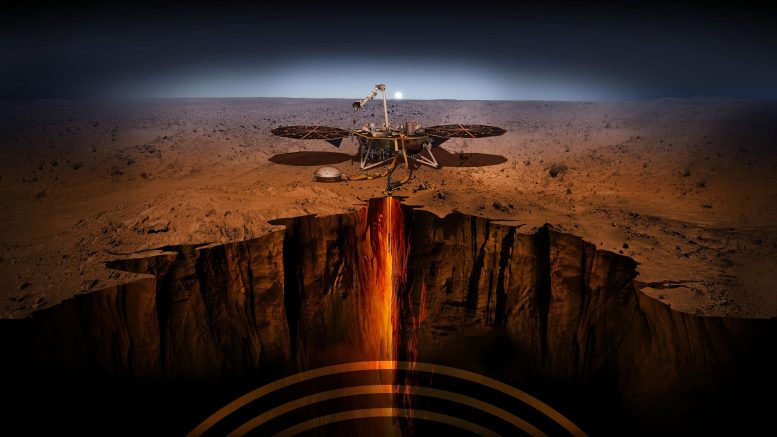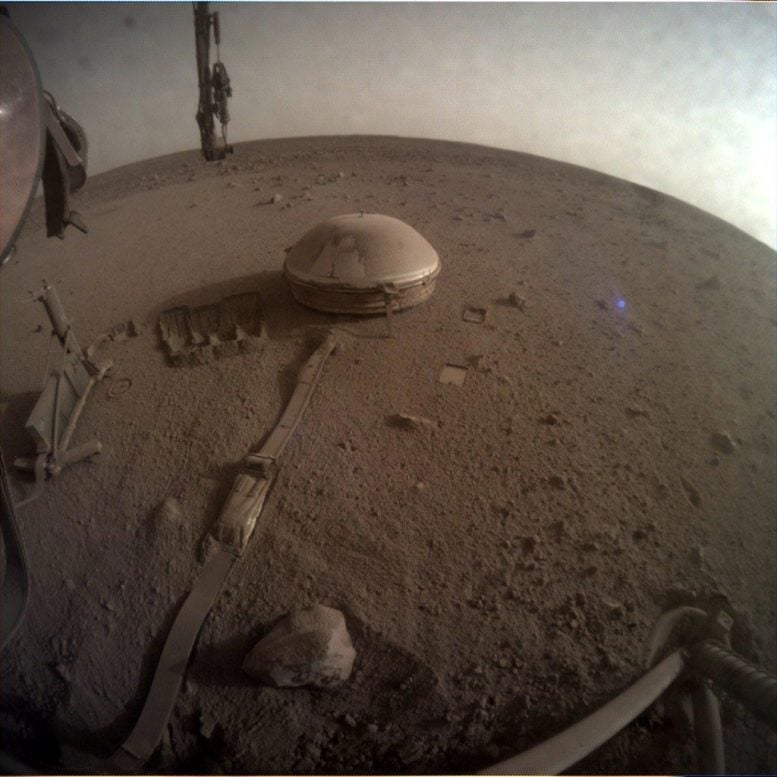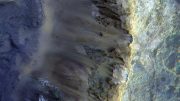
Researchers are exploring the potential of using seismoelectric signals from marsquakes to detect underground water on Mars, a method inspired by similar techniques on Earth but adapted for Mars’ unique conditions. This approach, which captures electromagnetic signals produced when seismic waves pass through aquifers, could reveal hidden water sources deep beneath the Martian surface, potentially revolutionizing our understanding of water on Mars and its distribution. Credit: NASA/JPL-Caltech
Penn State scientists are investigating the use of seismoelectric signals from marsquakes to identify deep underground water on Mars.
This technique, based on detecting electromagnetic fields generated by seismic waves, could provide new insights into Martian aquifers and water distribution.
Liquid water on Mars, if present today, might be buried too deeply for detection by traditional methods used on Earth. However, a new technique involving the analysis of marsquakes — earthquakes on Mars — might provide a breakthrough, suggest scientists from Penn State.
As quakes travel through underground aquifers, they generate electromagnetic signals. In a study published in the journal JGR Planets, the researchers demonstrated how these signals could potentially reveal the presence of water several miles beneath Mars’ surface. Lead author Nolan Roth, a doctoral candidate in the Department of Geosciences at Penn State, believes this method could pave the way for analyzing future Mars mission data.

One of the last images ever taken by NASA’s InSight Mars lander shows its seismometer on the red planet’s surface in 2022. A team of scientists suggest that using data from the seismometer and a magnetometer on the lander could help reveal whether liquid water is present deep under the Martian surface. Credit: NASA/JPL-Caltech
Potential of Marsquakes to Detect Subsurface Water
“The scientific community has theories that Mars used to have oceans and that, over the course of its history, all that water went away,” Roth said. “But there is evidence that some water is trapped somewhere in the subsurface. We just haven’t been able to find it. The idea is, if we can find these electromagnetic signals, then we find water on Mars.”
If scientists want to find water on Earth, they can use tools like ground-penetrating radar to map the subsurface. But this technology is not effective miles under the surface, depths where water may be on Mars, the scientists said.
Instead, the researchers recommend a novel application of the seismoelectric method, a newer technique developed to non-invasively characterize Earth’s subsurface. When seismic waves from an earthquake move through an aquifer underground, differences in how rocks and water move produce electromagnetic fields. These signals, which can be heard by sensors on the surface, can reveal information about aquifer depth, volume, location, and chemical compositions, according to the researchers.
Advantages of Seismoelectric Signals on Mars
“If we listen to the marsquakes that are moving through the subsurface, if they pass through water, they’ll create these wonderful, unique signals of electromagnetic fields,” Roth said. “These signals would be diagnostic of current, modern-day water on Mars.”
On water-rich Earth, using this method to identify active aquifers is challenging because water exists in the subsurface even outside of aquifers, creating other electric signals as seismic waves move through the ground. This background noise must be separated from the aquifers’ signals, the scientists said, for accurate identification and characterization.
“On Mars, where the near-surface is certainly desiccated, no such separation is needed,” said Tieyuan Zhu, associate professor of geosciences at Penn State and Roth’s adviser and co-author. “In contrast to how seismoelectric signals often appear on Earth, Mars’ surface naturally removes the noise and exposes useful data that allows us to characterize several aquifer properties.”
Simulating Mars’ Subsurface in Research
The researchers created a model of the Martian subsurface and added aquifers to simulate how the seismoelectric method would perform. They found they could successfully use the technique to analyze details about the aquifers, including how thick or thin they are and their physical and chemical properties, like salinity.
“If we can understand the signals, we can go back and characterize the aquifers themselves,” Roth said. “And that would give us more constraints than we’ve ever had before for understanding water on Mars today and how it has changed over the last 4 billion years. And that would be a big step ahead.”
Utilizing Existing Data and Tools on Mars
Roth said future work will — surprisingly — involve analyzing data already collected on Mars.
NASA’s Insight lander, launched in 2018, delivered a seismometer to Mars that has been listening to marsquakes and mapping the subsurface. However, seismometers have difficulty distinguishing water from gas or less dense rock.
However, the mission also included a magnetometer as a diagnostic tool to help the seismometer. Combining data from the magnetometer and the seismometer could reveal seismoelectric signals, the scientists said.
Sending a dedicated magnetometer meant to conduct scientific experiments on future NASA missions could potentially produce even better results, the researchers said.
Expanding Seismoelectric Research Beyond Mars
“This shouldn’t be limited to Mars — the technique has potential, for example, to measure the thickness of icy oceans on a moon of Jupiter,” Zhu said. “The message we want to give the community is there is this promising physical phenomena — which received less attention in the past — that may have great potential for planetary geophysics.”
Reference: “Characterizing Liquid Water in Deep Martian Aquifers: A Seismo-Electric Approach” by N. Roth, T. Zhu and Y. Gao, 05 May 2024, Journal of Geophysical Research: Planets.
DOI: 10.1029/2024JE008292
Yongxin Gao, professor at Hefei University of Technology in China, also contributed.
The Penn State E. Willard and Ruby S. Miller Fellowship and the National Natural Science Foundation of China supported researchers involved on this work.









Be the first to comment on "Marsquakes: A New Way to Discover Hidden Water Deep Underground on Mars"